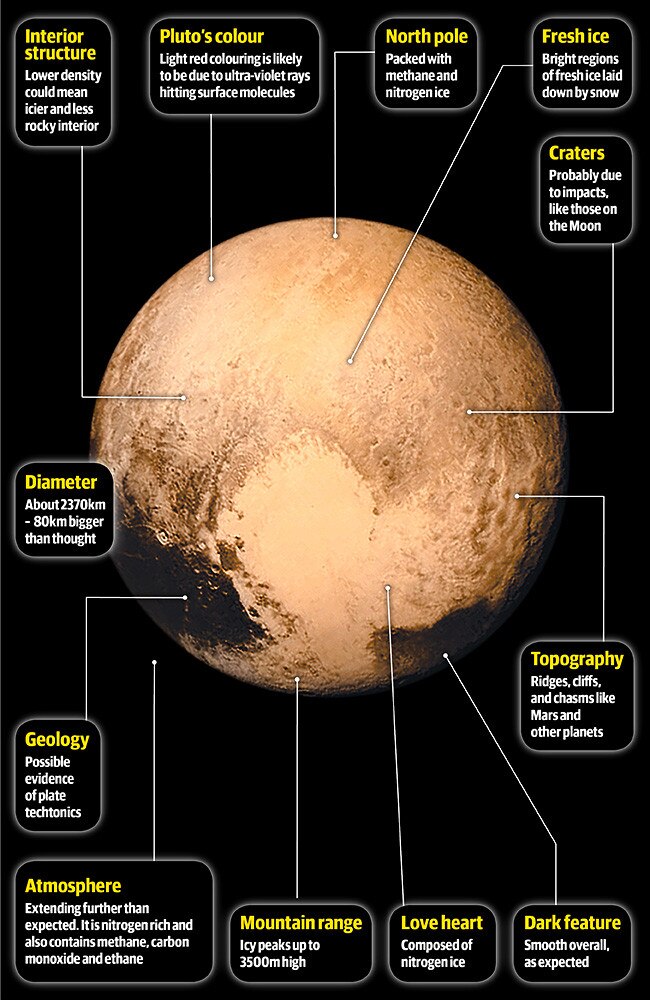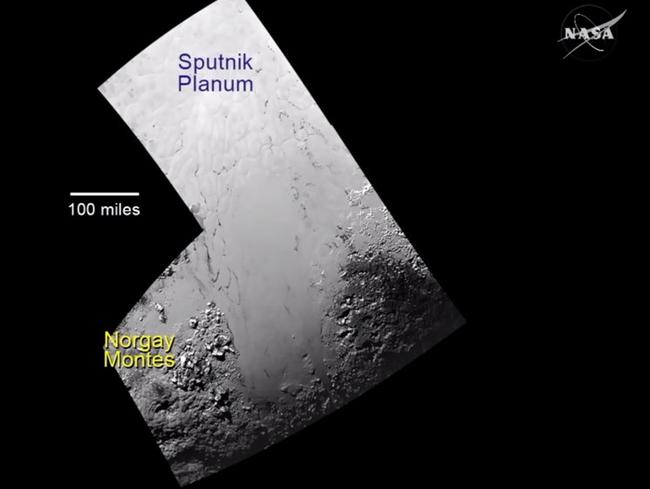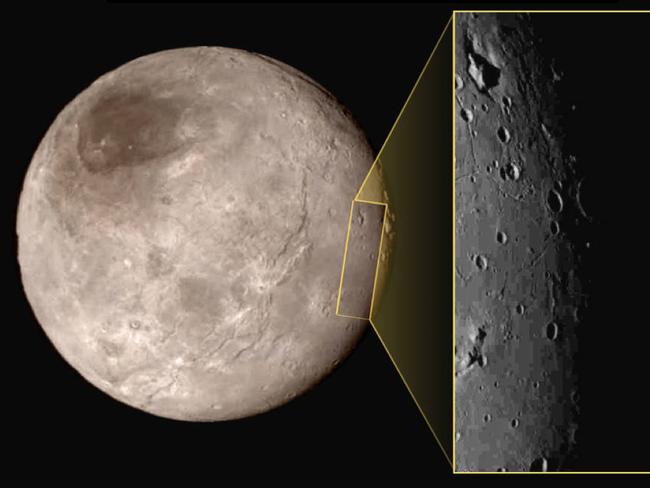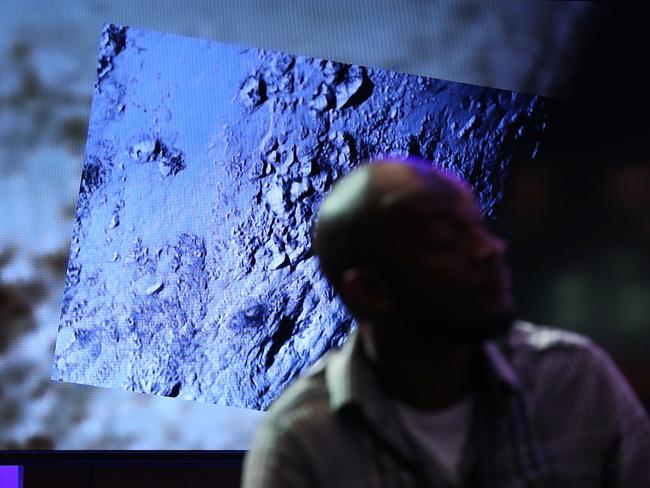Pluto fly-by puts you aboard the New Horizon’s mission of discovery
TAKE a ride — at 58,000 km/h and just 3500 metres high — over the mysterious ice mountains and strange frozen plains of Pluto. Then find out what we now know.
TAKE a ride — at 58,000 km/h and just 3500 metres high — over the mysterious ice mountains and strange frozen plains of Pluto. Then find out what we now know.
It was humanity’s first good look at the dwarf planet when the New Horizons probe flashed past Pluto early last week.
Now NASA has let us climb aboard.
“What you’re seeing is a scene that’s about a total width about 250 miles across — 400 kilometers,” said Alan Stern, New Horizons’ principal investigator. “These mountains soar as high above their local terrain as many of the mountains in the Rocky Mountains do here in the United States. Pretty impressive.”
Six views of Pluto revealing some of the weird & WONDERFUL terrain seen by @NASANewHorizons pic.twitter.com/7Q9YqBgjbK
— gregsmyerumsby (@gregsmyerumsby) July 19, 2015The Pluto fly past has provided plenty of surprises.
What was long thought to be an inert, featureless snowball has turned out to be a world apparently filled with icy geological activity.
It has a polar cap of methane and nitrogen. It has vast, smooth plains. It has deep canyons and soaring jagged mountains.
It was supposed to be a simple, dead snowball.
There is another element of mystery to be figured out: There are vast regions without meteorite craters, indicating they must relatively young.
Essentially, it looks as though Pluto has a molten radioactive core and tectonic plates.
This ice world is alive.

The plains of Pluto
New Horizon’s chief investigator Alan Stern to admit scientists had been “completely wrong” in their expectations of the icy world.
“They are very active. Pluto and Charon have been geologically active for billions of years, but we don’t know what the energy is that is driving it. It’s a puzzle,” he said at the weekend.
It’s the plains of Pluto (given the name Tombaugh Regio for discoverer Clyde Tombaugh) that have drawn the most attention. Spanning hundreds of miles, the fields are the prominent, bright, heart-shaped area of Pluto’s surface. Like the mountains to their south, the plains look to be a relatively young 100 million years old — at the most.
The plains — which include clusters of smooth hills and fields of small pits — are covered with irregular-shaped, or polygon, sections that look to be separated by eroded troughs. Each section is roughly 20 kilometres across

Another unexpected feature of the vast heart-shaped field is a disproportionately high concentration of carbon monoxide.
Scientists speculate internal heating — perhaps from icy volcanoes or geysers- might still be shaping these crater-free regions.
“This could be only a week old for all we know,” head of the New Horizons geological team Jeff Moore said.
He stressed that scientists have no hard evidence of erupting, geyser-like plumes on Pluto — yet.

Impossible ice crags
To the south of Pluto’s heart-shaped plains are jagged, sculpted mountains of water ice. But this is no normal ice: It’s so cold that it has become as dense as rock.
The 3.4km tall peaks have been given the informal name Norgay Montes. Tenzing Norgay was Sir Edumn Hillary’s Sherpa guide when he scaled Mount Everest in 1953.
It’s possible the mountainous terrain may have formed through contraction of dwarf planet’s deep-frozen surface during the more distant leg of its elliptical orbit around the sun. At the moment Pluto is a relatively balmy -230C as it begins its journey back out to the outer reaches of the Solar System.
I think someone spotted @DrFunkySpoon ! That long arrow is pointing right at Him! pic.twitter.com/TFupGDI4F6
— Pluto Major Planet (@plutosgems) July 16, 2015However it’s also possible they have been thrust upwards by activity generated by a molten core. The answer, scientists hope, remains buried in the gigabits of data still stored within New Horizons, waiting to be beamed back to Earth.
Also attracting attention is Pluto’s evaporating atmosphere. Made up of nitrogen gas, it has been observed to be creating a “tail” like a comet — streaming some 109,000km behind the dwarf planet.

Charon: Planet, dwarf planet or moon?
It’s half the size of Pluto, but only 10 per cent of its weight. It’s also the biggest moon in relation to the size of its home world in the Solar System.
It’s why Charon and Pluto swing about each other, orbiting a piece of space between them.
So is Charon a moon, or a world living in a close binary relationship with Pluto?
At the moment, there’s no talk of yet another reclassification for this unusual couple.
But Charon is certainly getting its fair share of attention.
It’s more heavily cratered than Pluto — though still less than expected. Does it also have geological activity giving it a refreshed face?
There’s an enormous rift valley. There are also epic mountains — including one that seems to have caused the surrounding terrain to sink under its weight.
Then there’s that big, dark smear at its pole. It’s big. It’s red. That’s about all we know — which is probably why it has been given the ominous name “Mordor”.

More to come
New Horizons is controlled by a hardened version of the original PlayStation One chip, running at 33Mhz. It was launched way back in 2006 after all.
But if you’re wondering why we’ve only a handful of photos from Pluto so far, it’s because the data transfer rate over five billion kilometres is only 1-2 Kbps (kilobits per second).
To put this in perspective, your average wi-fi server can pump out 300Mbps (megabits per second) even though Australia’s internet providers only give you about 7.4Mbps to start with — and you probably struggle to pick up its signal at the other end of the house.
The upshot: It takes about an hour to download a single high-resolution image from New Horizons. We won’t see everything the probe collected in its close pass for another 16 months.
Little more than one gigabit has been delivered. Up to 39 gigabits of data is sitting on its harddrives.
“This is just a taste of what I’m sure is in the unsent data” yet to come, Moore said.
@mesnitu @NewHorizons2015 A KBO flyby in 2019 (pending funding decision) for 2019 & then it's out of solar system. pic.twitter.com/r5vvRGqPnA
— Kimberly EnnicoSmith (@kennicosmith) July 19, 2015



